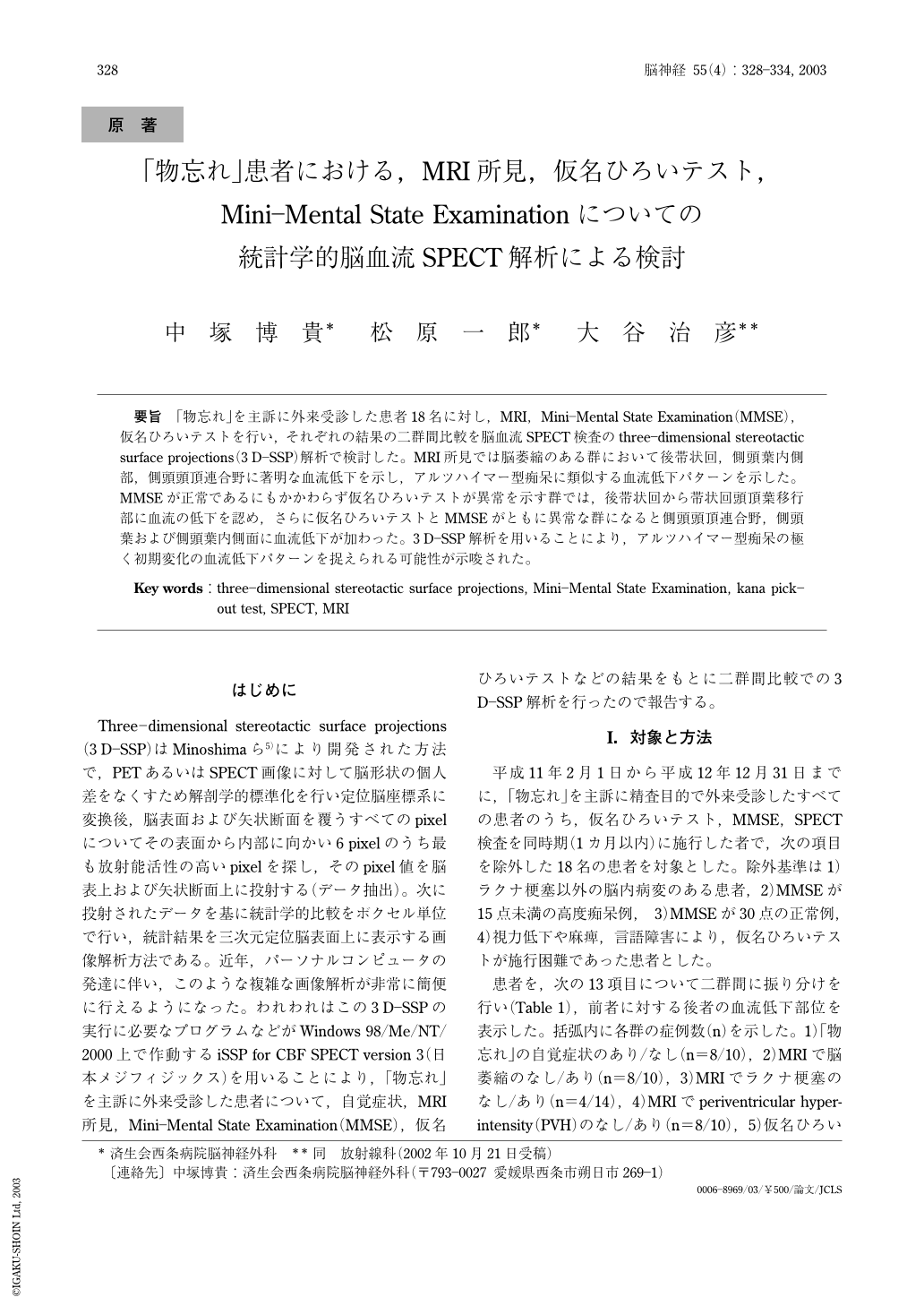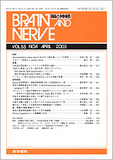Japanese
English
- 有料閲覧
- Abstract 文献概要
- 1ページ目 Look Inside
要旨 「物忘れ」を主訴に外来受診した患者18名に対し,MRI,Mini-Mental State Examination(MMSE),仮名ひろいテストを行い,それぞれの結果の二群間比較を脳血流SPECT検査のthree-dimensional stereotactic surface projections(3D-SSP)解析で検討した。MRI所見では脳萎縮のある群において後帯状回,側頭葉内側部,側頭頭頂連合野に著明な血流低下を示し,アルツハイマー型痴呆に類似する血流低下パターンを示した。MMSEが正常であるにもかかわらず仮名ひろいテストが異常を示す群では,後帯状回から帯状回頭頂葉移行部に血流の低下を認め,さらに仮名ひろいテストとMMSEがともに異常な群になると側頭頭頂連合野,側頭葉および側頭葉内側面に血流低下が加わった。3D-SSP解析を用いることにより,アルツハイマー型痴呆の極く初期変化の血流低下パターンを捉えられる可能性が示唆された。
The aim of this single photon emission computed tomography(SPECT) study was to determine the abnormality of the regional cerebral blood flow(rCBF) using a three-dimensional stereotactic surface projection(3D-SSP) in 18 patients who were referred to the hospital because of forgetfulness. Two intergroup comparison by 3D-SSP analysis was conducted based on MRI, kana pick-out test and Mini-Mental State Examination(MMSE) results. Of the MRI findings, in the brain atrophy group, rCBF was decreased in the posterior cingulate gyrus, medial temporal structure and parieto-temporal association cortex;these rCBF-decreased areas are similar to the Alzheimer disease pattern. In the group where the MMSE was normal but the kana pick-out test was abnormal, rCBF was decreased in the posterior cingulate gyrus and cinguloparietal transitional area. In the group where both the MMSE and kana pick-out test were abnormal, rCBF was decreased in the parieto-temporal association cortex, temporal cortex and medial temporal structure. These results suggest that 3D-SSP analysis of the SPECT with MMSE and the kana pick-out test provides the possibility of early diagnosis of initial stage of Alzheimer's disease.We developed a Japanese version of the Everyday Memory Checklist(EMC), which was originally made by Wilson et al. to assess everyday memory problems, and examined its reliability and validity in assessing brain-damaged patients with memory deficits.
Subjects and Methods:The subjects consisted of 393 brain-damaged patients with memory deficits aged between 17 and 90 years with the mean MMSE of 24.6, and 132 control subjects aged between 19 and 86 years with the mean MMSE of 28.5. Patients' everyday memory problems were both self-evaluated and evaluated by their caregivers, while those of control subjects were only self-evaluated with the EMC.
Results:The test-retest reliability of the EMC evaluated in 149 randomly selected patients was acceptably high with intraclass correlation coefficient(0.950 for caregiver-evaluated scores and 0.759 for self-evaluated scores). The standard memory test scores were significantly correlated with the EMC scores of the patients evaluated by the caregivers;among them the scores of the Rivermead Behavioural Memory Test were most highly correlated with the EMC scores. On the other hand, the scores of the non-memory cognitive test scores were not significantly correlated with the EMC scores. The self-evaluated EMC scores of the patients were significantly lower than those of the patients evaluated by the caregivers, and were not correlated with memory test scores or with non-memory cognitive test scores. As the EMC scores of control subjects over 60 years were significantly higher than the scores of the subjects under 59 years, we compared the EMC scores between the patients and the control subjects after we divided each subject into two groups depending on age. The EMC scores of the patients evaluated by the caregivers were significantly higher than the score of the control subjects in groups of both over 60 years and under 59 years. However, the self-evaluated EMC scores of the patient were not significantly higher than the EMC scores of the control subjects. In the analysis of the diagnostic accuracy, the EMC scores of the patients evaluated by the caregivers correctly classified 40.9% of patients and 92.9% of normal subjects by setting the cut-off scores of 14/15 in subjects under 59 years, and classified 50.2% of patients and 85.5% of normal subjects by setting the cut-off scores of 16/17 in subjects over 60 years.
Conclusion:When caregivers evaluated the amnesic patients, the Japanese version of the EMC is reliable and valid in assessing everyday memory problems.

Copyright © 2003, Igaku-Shoin Ltd. All rights reserved.


